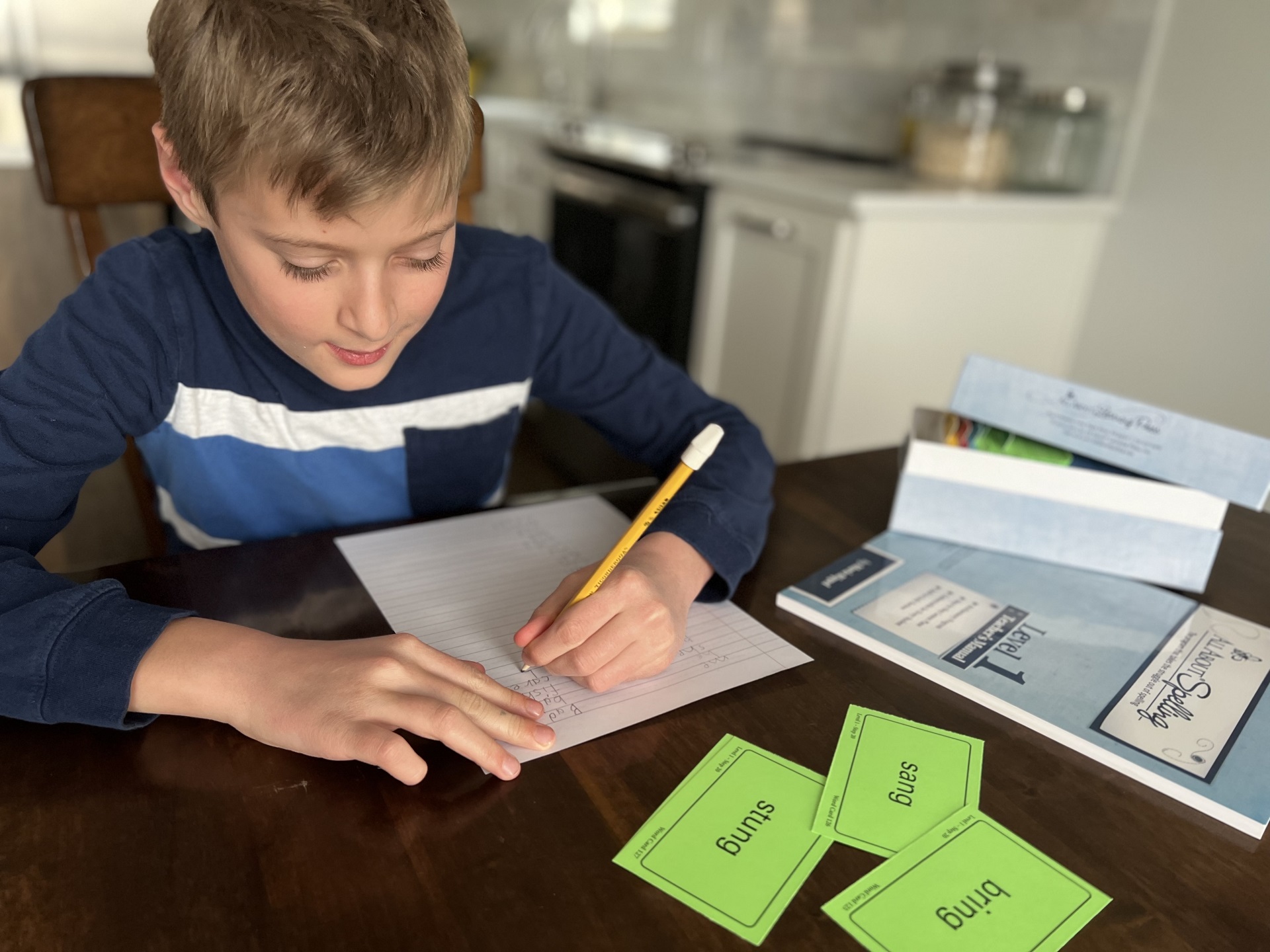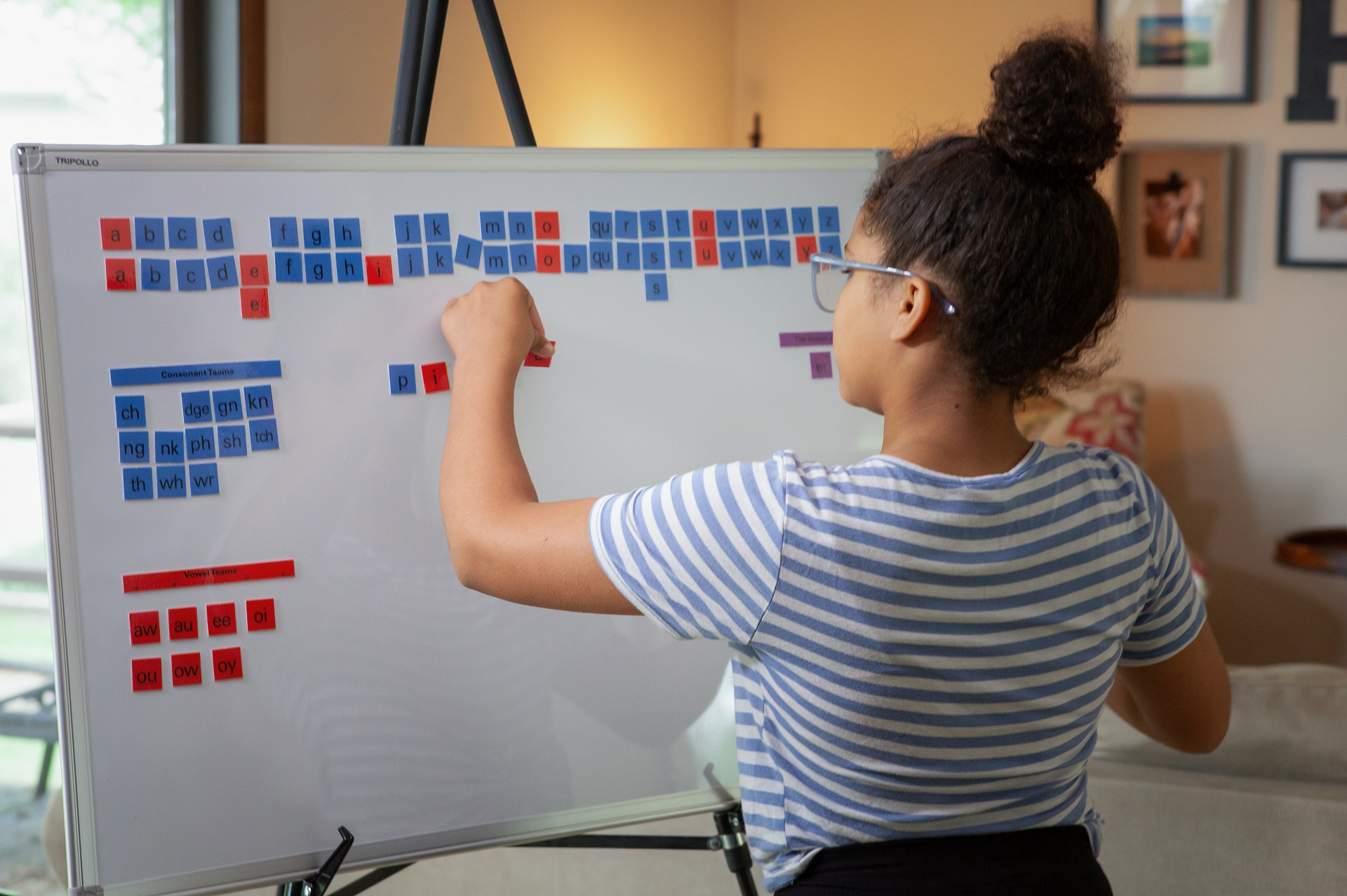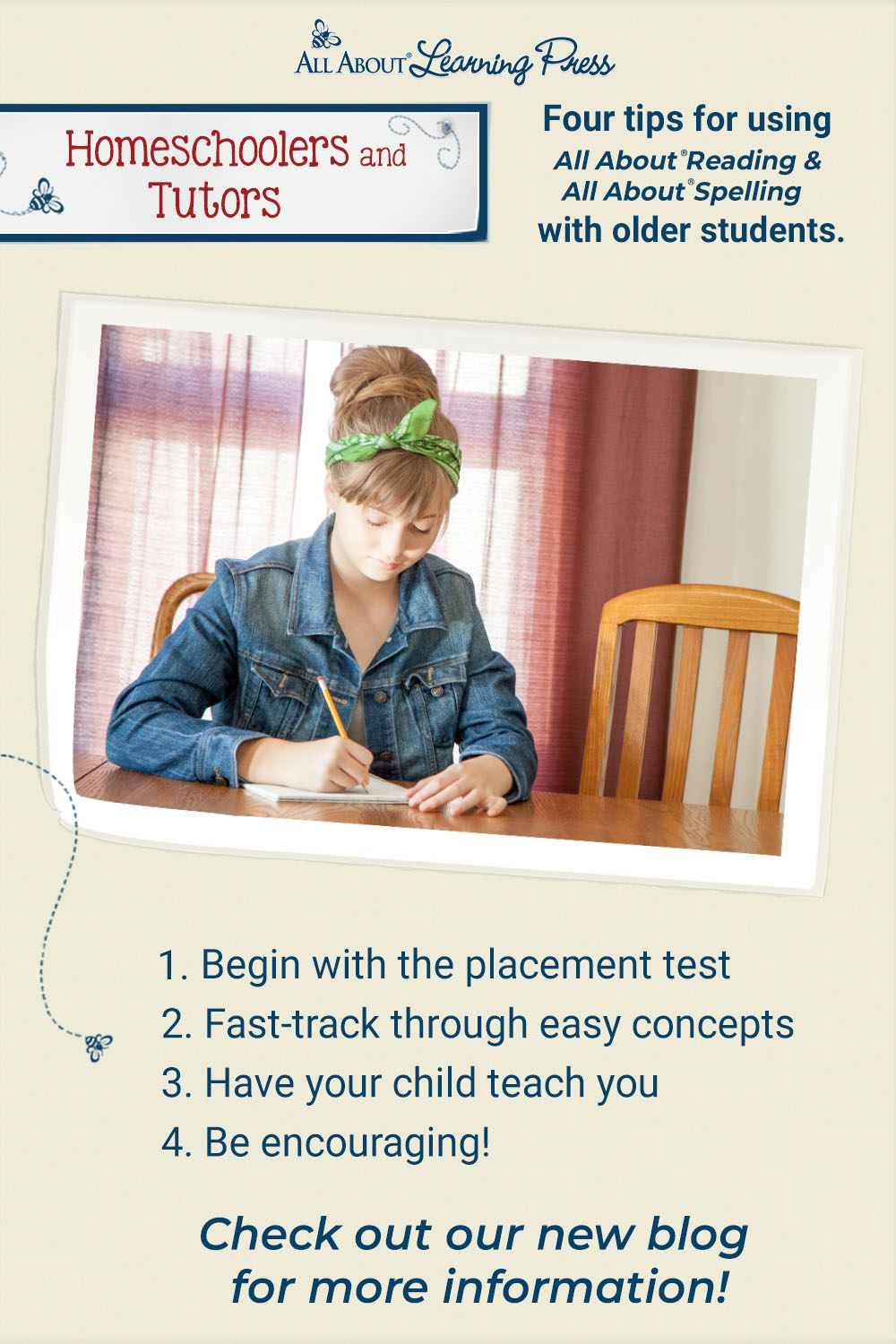Tips for Teaching Older Students

We’re often asked, “How can I use your programs with my older student?” Usually, the concern is that a middle or high school student might feel embarrassed by the full-color, hands-on activities included in All About Reading and All About Spelling.
However, with a few modifications, many people have found that our programs work well for teens and even adults!
4 Tips for Using All About Reading and All About Spelling with Older Students
Tip #1 for Teaching Older Students: Begin with the Placement Test
Our programs are not grade-level-specific, so the best way to determine which level your student should start with is to have them take either our Reading Placement Test or our Spelling Placement Test – or both!
In our reading program, it works fine for a student to begin at a higher level if they already have the skills taught at the lower levels. All About Reading contains all the materials you need to fill in any gaps your student may have, so you can start with the review lesson and then take the rest of the program at your student’s pace.
All About Spelling is structured differently; in this program, most students actually begin at Level 1. That’s because All About Spelling is a building-block program in which each level builds on the previous level. Because of the importance of laying a solid foundation, we generally don’t recommend starting higher than Level 2. However, we do encourage parents to customize the lessons for their students, moving quickly through concepts students have already mastered and slowing down when they reach new or difficult concepts.

It’s completely normal for your teenage student to initially balk at the idea of beginning our programs at Level 1 or 2, fearing that they’re for first—or second-grade students.
Take the opportunity to explain to your student that our levels have nothing to do with grade levels at all! Our programs are skills-based, and just like you wouldn’t start playing a brand new video game in Level 10 or join a swim team before you learn the basic strokes, reading and spelling also have a specific sequence of skills that must be mastered before moving on to more complex concepts. If they skip ahead, they’ll have gaps in their learning that may impact their reading and spelling success.
For example, even though most older students know how to spell the word “cat,” they often don’t actually know the rule behind why we choose a C instead of a K. Students learn this important foundational rule in All About Spelling Level 1. The same rule that applies to the word “cat” also applies to more complex words such as “Kindergarten” or “concrete.”
Reassure your student that starting at a lower level has nothing to do with grade levels, but that we take a “no gaps” approach to reading and spelling instruction!
Tip #2 for Teaching Older Students: Skip the Activities
In both of our programs, the full-color, hands-on activities are optional. They’re a fun, interactive way for students to practice the concepts they’ve been learning, but if your older student feels embarrassed by them, it’s okay to skip them! You’ll still be able to follow the lessons in the Teacher’s Manual and work through the concepts with your student without missing the heart of the program.
Our programs are robust and include many other types of practice in addition to the activities.
In All About Reading, we recommend fully utilizing the fluency sheets from the activity book and decodable readers to help build students’ skills, fluency, and confidence.

The Color Edition of All About Spelling includes Advanced Application sections targeted at older and/or advanced spellers. Older students will appreciate seeing how the “smaller” words they’re currently working on actually help them learn to spell larger words. There are also dictation words, phrases, and sentences built into the program to help students become proficient spellers.
Both programs include flashcards so you can fully customize your student’s review and give them the targeted instruction they need.
As with the activities, some teenagers may also feel that the physical letter tiles are too “childish” for them. In that case, your teenager might prefer the Letter Tiles for Learning app, which provides the same hands-on letter tiles work using a tablet instead.
Tips #3 for Teaching Older Students: Have Your Student Teach You
One of the simplest, most effective strategies for helping students fully understand a concept is having them teach it back to you.
Studies have shown that students who teach others a concept have “increased metacognitive processing,” “increased use of effective learning strategies,” “increased motivation to learn,” and “increased feelings of competence and autonomy.”1
Known as the “protégé effect,” this strategy is great to incorporate because it doesn’t have to be time-consuming or complicated!
During a lesson, it can be as simple as asking your student, “Why did you choose a K instead of a C in that word? Can you tell me more about how we know when to choose a C or K?” or “How did you know where to divide the word “cabin” into syllables?”
Taking this strategy one step further, you could plan to have your student teach a whole lesson back to you. Let them know that you’re going to be the student and they’re going to teach you. Then, have them teach you using the Rule Cards, Letter Tiles, and dictation phrases and sentences. Ask questions as they teach, and even make mistakes in your own spelling to give them a chance to correct you.
The more interactive you make it, the more your student will engage with the material and internalize it!
Tip #4 for Teaching Older Students: Encourage, Encourage, Encourage!
Struggling learners often have to work much harder to master the same skills that other students learn easily. Older students, especially, may feel discouraged by how challenging reading and/or spelling is to them, which is why they need a lot of encouragement! Giving your student meaningful feedback about their progress encourages them and shows them you’re noticing the effort they’ve invested.
Swap out phrases like “good job” and instead, try some of the following:
- “I like the way you chose CK instead of a K in the word “tick.” What made you spell it that way?”
- “This is such a tricky concept, and I love the way you just keep working at it!”
- “You’re right! Normally, an open syllable would make the vowel sound long. Remember the Never-Ending Rule? It says that English words never end in an “i.” So, keeping that in mind, how do we spell the word sky?”
Giving students feedback that is specific, positive, and constructive tells them exactly what they’re doing right and where they need to improve. It also guides and encourages students, building their confidence and motivating them to keep working hard.
All About Reading and All About Spelling are for Older Students, too!
We know that, at first glance, older students may feel that All About Reading and All About Spelling are designed for “little kids,” but by employing these strategies, many people have found the programs work well for students of all ages!
_________________________
1“The Protégé Effect: How You Can Learn by Teaching Others.” Effectiviology.com.
(https://effectiviology.com/protege-effect-learn-by-teaching/#How_to_use_the_protege_effect).








Kelsey
says:We just started over basically from square one with my two older kiddos. We’ve struggled for years and are coming back to thr foundation. This was a great article. I can’t wait to see their growth over the next couple months!
Robin
says: Customer ServiceKelsey,
Please reach out for help at any time! We offer life-time support and are always happy to help.
Tiffany S
says:I love this blog post. Even though I don’t have an older student, I still find this advice applicable. Especially tips #3&4 – have your student teach you and encourage their progress. It is a great formative assessment of their learning to ask questions to see if they understand the “why” behind what they are doing. I find myself constantly applying these tips – “Good job remembering the “e” on “carve.” Why did you need to put an e there?” Student, “Because English words don’t end in v.” Me, “Yes, that’s right! What are the other letters English words don’t end in?” Student, “English words don’t end in i, j, u, or v.”
Robin
says: Customer ServiceThank you, Tiffany! Great examples of questions to ask too.
Tee Burk
says:We love AAS for older students!
Robin
says: Customer ServiceThank you, Tee!
Christina
says:I love this program. We recently started skipping the activities with my 8 year old, instead we write silly stories with the practice sheets and he reads them back to me. He now looks forward to reading lessons. Thank you for this program!!
Robin
says: Customer ServiceYou’re welcome, Christina! Thanks for sharing what you’ve been doing with the program.
Victoria Hall
says:I homeschool my own kids, but I also tutor for a family in the public school. I am so glad to come across this blog and the information to aid in my tutoring sessions!
Robin
says: Customer ServiceYou’re welcome, Victoria! I’m glad this is helpful for you and your students.
Christy Viall
says:My son is in 5th grade. These are great ideas! I’m hoping to start this program with him soon.
Robin
says: Customer ServiceI’m glad this is helpful, Christy!
Sheryl
says:Thank you for this blog post. I recently stopped doing the activities with my older son and was questioning myself. Do you have plans to extend the letter tile app to laptop or iPhone? We don’t have a tablet and my son doesn’t like using the tiles. We have been using a white board and just writing out the tiles part of the lesson.
Robin
says: Customer ServiceSheryl,
You’re welcome. I’m glad this blog post was helpful.
_______
We will not be making the Letter Tiles app available for phones; there are just too many tiles and even the largest phones are too small for the app to be usable at that size.
As for laptops, if you have a touchscreen Chromebook, we did recently add the app for Chromebooks. It is purchased through Google Play.
The app is really designed to be used directly by touching and manipulating the tiles (versus using a mouse), which makes tablets ideal. From an instructional standpoint, learning is more memorable if the student can physically touch/manipulate the letter tiles. Using a mouse or touchpad to move tiles may not be as effective for students.
The demand for using the app on touchscreen computers other than Chromebooks hasn’t been very large yet, unfortunately, so our developer hasn’t expanded in that direction yet. (Each type of device requires different programming.)
I’ll share your interest with our developer; if the demand does increase, perhaps it’s something we can consider in the future.
_______
Teaching using a whiteboard can be effective, especially if you use different colors of dry-erase markers and underline vowel and consonant teams.
Hayley
says:Thanks for all of this info. My son is dyslexic and a little older. I’m about to start this program with him and hope he’ll learn well with this program. :)
Robin
says: Customer ServiceHayley,
I’m sorry to hear your son it struggle. I’m happy to help with any questions you have about placement or anything else. Let me know.
Here is a page of Free Resources for Teaching Students with Dyslexia that you should find helpful too!
Ashley
says:I’ve tried so many curriculums- I always come back to all about reading/spelling- for my kinders up to highschool. Really connects with Dyslexic Brain patterns 👏🏻
thank you!
Robin
says: Customer ServiceAshley,
Thank you!
Samantha
says:Thank you for the tips for older students. I started using this with my older ones last year and told them we were starting at level one to find out what everyone knew. We even had a “mom learned something new” moment that seemed to really help with realizing that anyone might need to start at that level.
Robin
says: Customer ServiceSamantha,
I love how you approached this with your students! Yes, even the teacher sometimes learns new things!
Janette
says:I really appreciate how both All About Reading and All About Spelling are easily adapted for older students. We have found this really helpful for our family where learning challenges abound.
Robin
says: Customer ServiceJanette,
We understand because many of us at AALP have taught older students with learning challenges! I’m glad this was helpful for you.
Kelly
says:These tips are great! Thank you for sharing!! 😊
Robin
says: Customer ServiceThank you, Kelly!
Donald
says:I liked this!
Robin
says: Customer ServiceThank you, Donald!
Amy
says:I love your program, and my twelve year old son is making great progress. I also skip most of the activities, since he thinks they’re for “little kiss “. I only wish that you would expand the app to laptop computers – we have laptops and iPhones, but no tablet, and I really think he’d do so much better with the tiles app.
Robin
says: Customer ServiceAmy,
It’s great to hear about your son’s progress! Thank you.
I have noted your question for the app to be expanded to computers. Thank you for that too.
Cheralyn Raymer
says:This is very helpful for me as a tutor using this program with a variety of ages. I would love to see a similar article with tips for using these programs when teaching online.
Robin
says: Customer ServiceI’m glad this was helpful for you, Cheralyn!
We do have some tips and requirements for using our materials online. You can email us at [email protected] for them.
Amanda B
says:For tip #3, having the student teach to you, I actually use this with my younger kids. Ziggy is still my 7 y/o daughter’s favorite character for basically all her school subjects, and my 10 y/o loves to change out stuffed animal buddies every day. I take advantage of their pretend play here, and have them help teach the concepts we’re learning to their stuffed animal students. It works so well, and they don’t have any idea how much I’m working to challenge them because they’re just busy having fun playing!
Robin
says: Customer ServiceAmanda,
I love that Ziggy and other soft friends gets involved, allowing learning to be more social and fun! And what great teaching to have your children teach concepts they have just learned to their stuffed animal students!
Rae C
says:I have used both programs with kids 5-14, and am now using AAS with a 40 year old! They really are good for any age, and so easy to customize.
Robin
says: Customer ServiceThank you, Rae! It great to hear that All About Spelling has worked well for you for such a wide range of student ages!
Nicole
says:Thank you for these tips. I especially like the differentiated encouragement for older readers.
Robin
says: Customer ServiceThank you, Nicole!
Emily
says:This is great info! I’m planning to use All About Spelling this year with my 14 and 11 year-olds!
Robin
says: Customer ServiceEmily,
I’m glad this will be helpful for you and your students! And we’re always available if you need help.
Jonalee Vanderhart
says:Love these tips!
Robin
says: Customer ServiceThank you, Jonalee!
Michelle C
says:Thank you for these tips! I have been using the spelling curriculum with my 11 year old since last year. He was very behind on spelling but starting at level 1, moving quickly through the parts he knew and pausing to fill in gaps, he’s been able to show massive improvements! I personally love the new color versions. He does prefer to skip the activities though so I appreciate the addition of the advanced application.
Robin
says: Customer ServiceMichelle,
I’m so excited to hear about your son’s great improvements! Great work! Thank you for sharing!